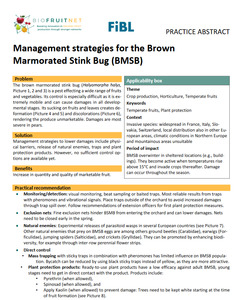{Tool} Management strategies for the Brown Marmorated Stink Bug (BMSB) (BIOFRUITNET Practice Abstract). Creator(s): Reinbacher, Lara and Boutry, Clémence. Issuing Organisation(s): FiBL - Research Institute of Organic Agriculture. Biofruitnet Practice Abstract, no. 060. (2023)
|
PDF
- Published Version
- German/Deutsch
(Bekämpfungsstrategien gegen die Marmorierte Baumwanze)
359kB | |
|
PDF
- Published Version
- English
(Management strategies for the Brown Marmorated Stink Bug (BMSB))
345kB | |
|
PDF
- Published Version
- French/Francais
(Stratégies de lutte contre la punaise diabolique)
359kB | |
![[thumbnail of 2024-10-29 18_43_33-Management strategies for the Brown Marmorated Stink Bug (BMSB) - 60.PA_Halyomor.png]](/45947/9.hassmallThumbnailVersion/2024-10-29%2018_43_33-Management%20strategies%20for%20the%20Brown%20Marmorated%20Stink%20Bug%20%28BMSB%29%20-%2060.PA_Halyomor.png)  Preview |
Image (PNG)
- Cover Image
- English
115kB |
Document available online at: https://orgprints.org/45947
Summary in the original language of the document
Increase in quantity and quality of marketable fruit.
Practical recommendation
• Monitoring/detection: visual monitoring, beat sampling or baited traps. Most reliable results from traps with pheromones and vibrational signals. Place traps outside of the orchard to avoid increased damages through trap spill over. Follow recommendations of extension officers for first plant protection measures.
• Exclusion nets: Fine exclusion nets hinder BSMB from entering the orchard and can lower damages. Nets need to be closed early in the spring.
• Natural enemies: Experimental releases of parasitoid wasps in several European countries. Other natural enemies that prey on BMSB eggs are among others ground beetles (Carabidae), earwigs (Forficulidae), jumping spiders (Salticidae), and crickets (Gryllidae). They can be promoted by enhancing biodiversity, for example through inter-row perennial flower strips.
• Direct control
• Mass trapping with sticky traps in combination with pheromones has limited influence on BMSB population. Bycatch can be reduced by using black sticky traps instead of yellow, as they are more attractive.
• Plant protection products: Ready-to-use plant products have a low efficacy against adult BMSB, young stages need to get in direct contact with the product. Products include:
• Pyrethrin (when allowed),
• Spinosad (when allowed), and
• Apply Kaolin (when allowed) to prevent damage: Trees need to be kept white starting at the time of fruit formation.
| EPrint Type: | Practice tool |
|---|---|
| What problem does the tool address?: | The brown marmorated stink bug (Halyomorpha halys) is a pest effecting a wide range of fruits and vegetables. Its control is especially difficult as it is extremely mobile and can cause damages in all developmental stages. Its sucking on fruits and leaves creates deformation and discolorations, rendering the produce unmarketable. Damages are most severe in pears. |
| What solution does the tool offer?: | Management strategies to lower damages include physical barriers, release of natural enemies, traps and plant protection products. However, no sufficient control options are available yet. |
| Country: | Switzerland |
| Type of Practice Tool: | Practice abstracts |
| Keywords: | Temperate fruits, plant protection |
| Agrovoc keywords: | Language Value URI English temperate fruits http://aims.fao.org/aos/agrovoc/c_7655 English plant protection http://aims.fao.org/aos/agrovoc/c_5978 |
| Subjects: | Crop husbandry > Production systems > Fruit and berries Crop husbandry > Crop health, quality, protection |
| Research affiliation: | European Union > Horizon 2020 > Biofruitnet Switzerland > FiBL - Research Institute of Organic Agriculture Switzerland > Crops > Special crops > Fruit European Union > Organic Farm Knowledge |
| Horizon Europe or H2020 Grant Agreement Number: | 862850 |
| Related Links: | https://organic-farmknowledge.org/tool/45947, https://biofruitnet.eu |
| Project ID: | ofk |
| Deposited By: | Basler, Andreas |
| ID Code: | 45947 |
| Deposited On: | 26 Apr 2023 07:52 |
| Last Modified: | 29 Oct 2024 17:44 |
| Document Language: | English, German/Deutsch, French/Francais |
| Status: | Published |
Repository Staff Only: item control page

 Download Statistics
Download Statistics Download Statistics
Download Statistics
